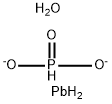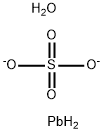LEAD PHOSPHITE, DIBASIC
- CAS NO.:12141-20-7
- Empirical Formula: H5O4PPb-2
- Molecular Weight: 307.21
- MDL number: MFCD00049644
- EINECS: 235-252-2
- SAFETY DATA SHEET (SDS)
- Update Date: 2023-09-20 18:48:35

What is LEAD PHOSPHITE, DIBASIC?
Chemical properties
solid
Chemical properties
Dibasic lead phosphite is a white crystalline powder, sp gr 6.9, refractive index 2.25, lead oxide content 90.2%, sieve analysis, 99.8% through 44 μm (325 mesh) (wet), water solubility, nil.
The Uses of LEAD PHOSPHITE, DIBASIC
Fields of application for dibasic lead phosphite stabilizers in PVC include garden hose, flexible and rigid vinyl foams (as high temperature activator for azodicarbonamide-type blowing agents), coated fabrics, plastisols, electrical insulation, and extruded profiles for outdoor use. In general, at five parts per hundred of resin (5 phr), dibasic lead phosphite provides good heat stability and superior outdoor weathering properties in PVC. This stabilizer should be stored in closed containers, away from open flames, and at temperatures below 200 °C. Exposure to sparks or static electricity should be avoided by grounding all electrical equipment and using wooden scoops.
Flammability and Explosibility
Flammable
Properties of LEAD PHOSPHITE, DIBASIC
| Water Solubility | 12.2mg/L at 20℃ |
| Stability: | Stability |
| CAS DataBase Reference | 12141-20-7(CAS DataBase Reference) |
| EPA Substance Registry System | Dibasic lead(II) phosphite (12141-20-7) |
Safety information for LEAD PHOSPHITE, DIBASIC
Computed Descriptors for LEAD PHOSPHITE, DIBASIC
New Products
4-AMINO-TETRAHYDRO-PYRAN-4-CARBOXYLIC ACID HCL 4-(Dimethylamino)tetrahydro-2H-pyran-4-carbonitrile 4-Aminotetrahydropyran-4-carbonitrile Hydrochloride (R)-3-Aminobutanenitrile Hydrochloride 3-((Dimethylamino)methyl)-5-methylhexan-2-one oxalate 1,4-Dioxa-8-azaspiro[4.5]decane 5-Bromo-2-nitropyridine Nimesulide BP Aceclofenac IP/BP/EP Diclofenac Sodium IP/BP/EP/USP Mefenamic Acid IP/BP/EP/USP Ornidazole IP Diclofenac Potassium THOMAIND PAPER PH 2.0 TO 4.5 1 BOX BUFFER CAPSULE PH 9.2 - 10 CAP SODIUM CHLORIDE 0.1N CVS ALLOXAN MONOHYDRATE 98% PLATINUM 0.5% ON 3 MM ALUMINA PELLETS (TYPE 73) LITHIUM AAS SOLUTION 2-Bromo-1-(bromomethyl)-3-chloro-5-nitrobenzene 2-Bromo-3-nitroaniline N-(3-Hydroxypropyl)-N-methylacetamide 3-Bromo-6-chloropyridazine 4-ethyl-3-nitrobenzoic acidRelated products of tetrahydrofuran








You may like
-
 1-Methyl-6-oxo-1,6-dihydropyridazine-3-carbonitrile 98%View Details
1-Methyl-6-oxo-1,6-dihydropyridazine-3-carbonitrile 98%View Details
99903-60-3 -
 88491-46-7 98%View Details
88491-46-7 98%View Details
88491-46-7 -
 1823368-42-8 98%View Details
1823368-42-8 98%View Details
1823368-42-8 -
 2-(3-(tert-butyl)phenoxy)-2-methylpropanoic acid 1307449-08-6 98%View Details
2-(3-(tert-butyl)phenoxy)-2-methylpropanoic acid 1307449-08-6 98%View Details
1307449-08-6 -
 Ethyl 3-(furan-2-yl)-3-hydroxypropanoate 25408-95-1 98%View Details
Ethyl 3-(furan-2-yl)-3-hydroxypropanoate 25408-95-1 98%View Details
25408-95-1 -
 2-Chloro-5-fluoro-1-methoxy-3-methylbenzene 98%View Details
2-Chloro-5-fluoro-1-methoxy-3-methylbenzene 98%View Details
1805639-70-6 -
 1784294-80-9 98%View Details
1784294-80-9 98%View Details
1784294-80-9 -
 Lithium ClavulanateView Details
Lithium ClavulanateView Details
61177-44-4